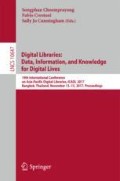Abstract
Academic database systems are vitally important tools for enabling researchers to find relevant, useful articles. Identifying how researchers select documents from search results is an extremely useful measure for improving the functions or interfaces of academic retrieval systems. This study aims to reveal which elements are checked, and in what order, when researchers select from among search results. It consists of two steps: an observational study of search sessions performed by researchers who volunteered, and a questionnaire to confirm whether extracted elements and patterns are used. This article reports findings from the observational study and introduces questions we developed based on the study. In the observational study we obtained data on nine participants who were asked to search for documents using information retrieval systems. The search sessions were recorded using a voice recorder and by capturing screen images. The participants were also asked to state which elements they checked in selecting documents, along with the reasons for their selections. Three patterns of order of checking were found. In pattern 1, seven researchers used titles and abstracts as the primary elements. In pattern 2, the others used titles and then accessed the full text before making a decision on their selection. In pattern 3, one participant searched for images and accessed the full text from the link in those pictures. We also found participants used novel elements for selecting. We subsequently developed items for a questionnaire reflecting the findings.
Access this chapter
Tax calculation will be finalised at checkout
Purchases are for personal use only
References
Liyana, S., Noorhidawati, A.: How graduate students seek for information: convenience or guaranteed result? Malays. J. Libr. Inf. Sci. 19(2), 1–15 (2014)
Pajić, D.: Browse to search, visualize to explore: who needs an alternative information retrieving model? Comput. Hum. Behav. 39, 145–153 (2014)
Wang, P., Soergel, D.: A cognitive model of document use during a research project. Study I. Document selection. J. Am. Soc. Inf. Sci. 49(2), 115–133 (1998)
Macedo-Rouet, M., Rouet, J.-F., Ros, C., et al.: How do scientists select articles in the PubMed database? An empirical study of criteria and strategies. Eur. Rev. Appl. Psychol. 62(2), 63–72 (2012)
Xie, I., Benoit III, E.: Search result list evaluation versus document evaluation: similarities and differences. J. Documentation 69(1), 49–80 (2013)
Nicholas, D., Huntington, P., Jamali, H.R.: The use, users, and role of abstracts in the digital scholarly environment. J. Acad. Librarianship 33(4), 446–453 (2007)
Hagiwara, Y., Wu, M., Mizutani, E., et al.: An experiment to identify how researchers select documents from search results. In: Proceedings of CiSAP Workshop 2015, pp. 8–11 (2015)
Hagiwara, Y., Ishita, E., Mizutani, E., et al.: A preliminary study and analysis to identify key elements in document selection. In: Information Seeking in Context, ISIC 2016, Zadar (2016)
Bae, S., Marshall, C.C., Meintanis, K., et al.: Patterns of reading and organizing information in document triage. In: ASIST Proceedings, vol. 43, no. 1, pp. 1–27 (2007)
Stelmaszewska, H., Blandford, A.: From physical to digital: a case study of computer scientists’ behavior in physical libraries. Int. J. Digit. Libr. 4(2), 82–92 (2004)
Acknowledgements
This work is supported by JSPS KAKENHI Grant Number JP15H01721.
Author information
Authors and Affiliations
Corresponding author
Editor information
Editors and Affiliations
Rights and permissions
Copyright information
© 2017 Springer International Publishing AG
About this paper
Cite this paper
Hagiwara, Y., Ishita, E., Mizutani, E., Fukushima, K., Watanabe, Y., Tomiura, Y. (2017). Identifying Key Elements of Search Results for Document Selection in the Digital Age: An Observational Study. In: Choemprayong, S., Crestani, F., Cunningham, S. (eds) Digital Libraries: Data, Information, and Knowledge for Digital Lives. ICADL 2017. Lecture Notes in Computer Science(), vol 10647. Springer, Cham. https://doi.org/10.1007/978-3-319-70232-2_20
Download citation
DOI: https://doi.org/10.1007/978-3-319-70232-2_20
Published:
Publisher Name: Springer, Cham
Print ISBN: 978-3-319-70231-5
Online ISBN: 978-3-319-70232-2
eBook Packages: Computer ScienceComputer Science (R0)

